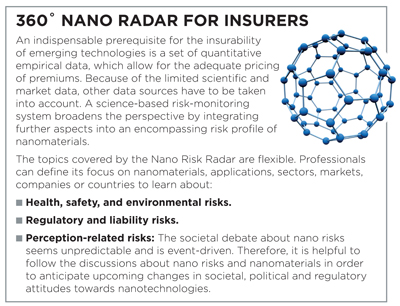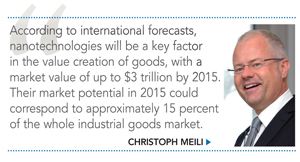Christoph Meili is the CEO of The Innovation Society, St.Gallen (Switzerland), an international consulting company that advises the insurance industry and regulators in risk-management and governance of nanotechnology. Dr. Meili is a senior lecturer at the University of St.Gallen and may be reached atchristoph.meili@innovationsgesellschaft.ch
Nanomaterials are commonly used in many industrial and consumer products. Aside from their beneficial properties, certain nanomaterials can also pose substantial risks to human health and the environment. Nanomaterials are implicitly covered in insurance policies. Liability insurers should therefore check their portfolios and investigate whether and what kind of nano-related risks are covered in their policies.
At the same time, insurers must stay abreast of new scientific data about potential risks of specific nanomaterials and regulatory developments, which must be followed continuously. Unexpected losses in liability lines of business could be avoided, if appropriate underwriting options are developed timely.
Increasing Nano Product Sales From self-cleaning windows and scratch-resistant colors and lacquers, to transparent sunscreens, antimicrobial plastering, packaging materials and textiles, an array of nano products are available. There are a fast-growing number of industry and consumer products which contain nanomaterials (NM). According to the European Commission, “nanomaterial” refers to a natural, incidental or manufactured material containing particles, in an unbound state or as an aggregate or as an agglomerate and where, for 50 percent or more of the particles in the number size distribution, one or more external dimensions is in the size range of 1-100 nm (1 nm = 10-9 m).” Compared to corresponding bulk materials, nanomaterials often show new physical and chemical properties. Therefore they are often used in nanotechnologically improved products and applications.
 For example, in Germany there are approximately 2,000 companies and research organizations related to nanotechnology. Forty-four percent are small- and medium-sized enterprises (SME), while 41 percent are research organizations and university labs, and 15 percent are major companies. In 2011, there were 64,000 workers involved in nanotechnologies and a turnover of 14.3 billion euro was generated by German nano companies. Because of the cross-sectional character of nanotechnologies, the sales volumes of nanomaterials and nanoproducts are increasing in all industries. In the color and lacquer industry, it is projected that by 2020 already 20 percent of the total business sales are generated by nano-components—for example, smart coatings—as the above mentioned antimicrobial and scratch-resistant ingredients.
For example, in Germany there are approximately 2,000 companies and research organizations related to nanotechnology. Forty-four percent are small- and medium-sized enterprises (SME), while 41 percent are research organizations and university labs, and 15 percent are major companies. In 2011, there were 64,000 workers involved in nanotechnologies and a turnover of 14.3 billion euro was generated by German nano companies. Because of the cross-sectional character of nanotechnologies, the sales volumes of nanomaterials and nanoproducts are increasing in all industries. In the color and lacquer industry, it is projected that by 2020 already 20 percent of the total business sales are generated by nano-components—for example, smart coatings—as the above mentioned antimicrobial and scratch-resistant ingredients.
The situation in other industries is similar. According to international forecasts, nanotechnologies will be a key factor in the value creation of goods, with a market value of up to $3 trillion by 2015. Their market potential in 2015 could correspond to approximately 15 percent of the whole industrial goods market. A large part of the global goods production, for example in the areas of health, information and communication technology, energy and environmental technology would be based on the application of nanotechnology knowledge.
An Unclear Risk Profile Nanomaterials have often been critically discussed in the past few years with regard to their potential adverse effects on human health and the environment. Even though scientific risk research on nanomaterials has been undertaken for over 10 years, it is still premature to determine potential adverse effects on human health and the environment in the mid- and longterm perspective. In addition to physical and chemical data, especially related to exposure, data is needed to address human and eco-toxicological effects. Nanomaterials that are bound or embedded in a solid matrix pose a low or even negligible risk, according to many experts. By contrast, unbound, powdered or airborne particles could be inhaled and enter the bloodstream through the lungs. In the bloodstream particles can enter cells. Some particles have actually been found in the nucleus and interacting with cellular structures.
Carbon nanotubes (CNT), which are long, fiber-shaped nano molecules have been found to cause inflammation and asbestos-cancer-like malignant tumors in mice. Nanoparticles can also enter the body through digestion. However, there are comparatively few data on the behavior of nanomaterials in the intestinal tract that demonstrate that titaniumdioxide nanoparticles (commonly used in food) cause inflammatory reactions and have genotoxic effects in cells of in the intestine. In the environment there are persistent and bioactive nanomaterials that are critically examined. Today no final judgment of the potential risks of specific nanomaterials in the middle or longterm perspective is possible. A “long-tail” risk potential for certain nanomaterials, however, cannot be excluded.
Potential Loss Exposure A recent study published by Gen Re demonstrates that nanotechnologies pose potential risks to liability insurances due to the enormous global use of nanomaterials in industry and consumer products. According to Gen Re this could affect liability insurances in the following liability lines of business:
- Comprehensive general liability (CGL)
- Product liability insurance
- Environmental liability insurance
- Product recall
- Workers’ compensation
The increasing number of compensation claims, the complexity of nanotechnologies and the unlimited passive legal protection for consumers offered by liability insurance policies could easily cause tremendous costs to elaborate defense.
In a position paper the Chief Risk-Officers Forum describes both: the opportunities and the challenges which the insurance industry faces with nanotechnologies. Given the enormous economic potential it seems vital for insurance companies not to ban nanotechnologies from insurance policies. Exclusion of nanotechnologies is no option. In fact, understanding the potential risks of nanomaterials and promoting risk awareness and risk management among the insured companies seems to be crucial. Thus, long-term damages, as happened in the case of asbestos, could be avoided.
Nevertheless, the Gen Re study states that today most insurance companies do not look into the matter of nano risks at all. Furthermore, the current situation could be called a “waiting period” in the insurance industry. It is recommended that the insurance companies should rather anticipate the potential developments, monitor the ongoing risk research and international regulation with a systematic “Risk-Radar” (refer to the box above).
 No Nano Registry In SightNanomaterials are regulated on national and international levels. In the European Union, for example, there are several regulations applicable to nanomaterials. Most of the present regulations on EU level and above do not refer explicitly to nanomaterials or nano-specific properties of the chemicals or products. Many critics and even authorities argue that nanomaterials are not treated adequately in current regulations.
No Nano Registry In SightNanomaterials are regulated on national and international levels. In the European Union, for example, there are several regulations applicable to nanomaterials. Most of the present regulations on EU level and above do not refer explicitly to nanomaterials or nano-specific properties of the chemicals or products. Many critics and even authorities argue that nanomaterials are not treated adequately in current regulations.
Today there is only one country in the world (France) which has started a mandatory registry for nanomaterials. On the European and also at the global level there is no official registry of nanomaterials and nanoproducts available. A registry of nanomaterials in the European Union has been discussed since 2008 but has never been started. Therefore there is a growing lack of information concerning the use and application of nanomaterials on the market. There is a systematic shortage of data concerning nanomaterials along the value-chain. Downstream users often lack data about nanomaterials which are used in their processes or products. Therefore it seems very difficult for insurance companies to get nano-specific information and data from their insured customers. Thus, liability insurers have to determine the risk profiles in their portfolio with external data and expertise.
In conclusion, liability insurers have to meet the challenges of nanotechnologies. The uncertainties in the risk profile of certain nanomaterials can be handled by:
- Checking new and existing liability policies in the portfolios for hidden nano risks.
- Raising customer (external) and underwriter (internal) awareness of potential nano risks.
- Developing appropriate underwriting strategies with risk-specific signing policies
- Continuous monitoring, based on the state-of-the-art of science and technology.
Thus, insurers can profit from booming nanotechnologies. They can price their nano policies adequately. On the other hand they can avoid unforeseen late damages and losses through “long-tail” risks of nanomaterials.
Fonte: Property Casualty 360°

